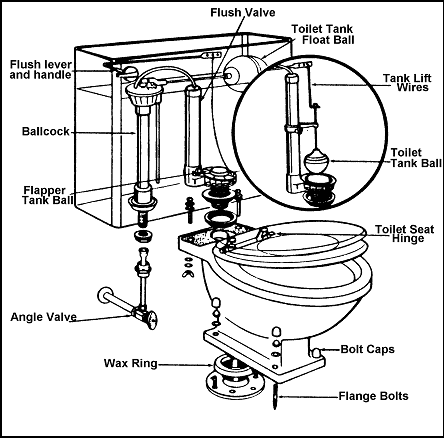Water Leak Information
Toilet Leak Detection
Leaking toilets are the most common cause of high water bills. Even a silent toilet leak (that’s one you normally can’t hear) will waste from 30 to 500 gallons per day! The ones you can hear will waste much, much more. Such water loss can normally be attributed to a faulty water level adjustment or to a leaky flapper.

Most People Will Say Their Toilet Does Not Leak
There is one sure way to find out. Make sure the toilet bowl has clean water in it. Put some food dye in the tank and then leave for 15 minutes. When you return, look into your bowl. If there is dye color in the bowl, or if you can hear or see water running in your bowl, its time for a new flapper!
After installing the new flapper, run the dye test again to assure you have no leak. If the leak persists (and every now and then it will), you are probably going to have to replace the entire flush valve.
Many toilets really do run only at night; that’s because people use much less water during these hours and in many municipal water systems, the water pressure rises considerably during this time.
It is not uncommon for system water pressure to rise by 15 to 20 pounds per square inch (psi), and by as much as 30 psi in some situations. This rise in pressure could cause “water creep” inside your gravity fed tank by 1/2″ or more. Most manufacturers of toilets normally suggest that the water level be set at approximately one inch below the top of the overflow tube. If you notice your toilet running in the middle of the night, there is a good chance that the water level in your tank is set too high.
To repair this, you should carefully bend the float arm so the float drops about 1/2″. Flush to be certain this will not interfere with the ball or flapper opening and closing properly. Wait until the following morning. If the water level is now below the overflow, the problem is fixed. If not, bend the float 1/2″ more and recheck the following morning. If the water level is still high remove the float and shake it to check for water inside which could mean a hole in the float. Replace if necessary.
Faucet Leak Detection
Check all faucets for leaks including the faucets used to fill your washing machine and your outside faucet. Most faucet leaks are plainly visible as drips coming out of the faucet aerator. Occasionally faucets may leak in other places such as the on/off handle or in the pipes below the basin. Leaks should be fixed immediately since they can quickly develop into a serious break. If you find a fixture that is leaking, turn off the shut off valve for that device. Try to tighten any fittings that leak. A quarter or half turn with a wrench might do the trick. Be careful not to over tighten fittings. You may not think a dripping faucet would use much water but here’s something to consider.
60 drops per minute = 192 gallons or 25.6 cubic feet per month
90 drops per minute = 310 gallons or 41.3 cubic feet per month
120 drops per minute = 429 gallons or 57.2 cubic feet per month
